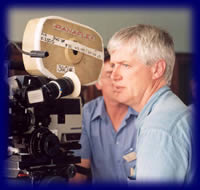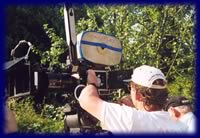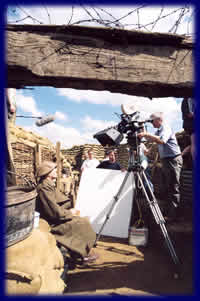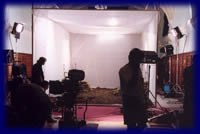|
Camera Team
DoP: Alistair Mckenzie
Focus: Richard Bevan
Loader: Alex Taylor
Video Assist: Simon Foggin
Cinematographer , Alistair Mckenzie
describes his involvement with the
'Wilfred' project.
|
|
One of the Cinematographer’s main creative responsibilities is to help the director achieve the film’s ‘Look’. This is extremely rewarding, but it comes with a series of headaches that generally don't subside until well after the film is 'in the can'. When the gods are in your favour, it can be as fulfilling as an artist painting on canvas. (On film, a Cinematographer paints tone and colour with light and shadows.)
|
|
At other times, when time and the elements are against you, it seems like slapping paint over ever widening cracks! The trick, if there is one, is to keep going, keep your eye on maintaining 'the look', and always be aware of the people around you.
|

|
|
|
Cinematography is truly a team effort. You could try doing it all yourself but unless you've got an endless schedule and an infinite budget your not going to get very far. The results of a good team certainly outweigh the talents of individuals and on Wilfred we had a great team.
|
|
The History
Peter Kershaw and I have worked with each other on and off for seven years. Peter knew that I had a film background and he was looking for someone to shoot a series with him. We hit it off from day one. His attention to detail and immaculate schedule gave me the freedom to do my job; to use the time we had to the full, and go for the shots that one rarely attempts, even on bigger budgeted productions.
|
|
|
|
|
|
Two successful television series later, we started to talk about the Wilfred project: to shoot a high quality 'short' film inspired by the last two years in the life of the great English poet, Wilfred Owen and to introduce the newly formed 'Duchy Parade Films' production company.
|
|
The Look
From the start, Wilfred had to look big i.e. cinematic. The poetry that is taught in every school about the futility of war, had to be played on a big screen, and I had no hesitation in suggesting 35mm Panavision as the format.
|

|
|
|
As the intended distribution included the smaller independent cinemas we also chose to stick with the universal standard aspect ratio of 1.85:1 and an optical soundtrack.
|
|
The technical Challenge
24 fps v. 25 fps.
|
|
|
|
The creative Challenge
Wilfred was always going to be a challenging project creatively: an amalgam of live action and animation on a controlled budget. The challenge seemed all the greater after seeing the impressive pre-production artwork done by the animators; Dave Bunting and Robert Jefferson and the paintings of Yvonne Elvin.
|
|
Certainly this artwork set the mood, but Peter and I also wanted to make the live action a contrast; the animation reflecting the mind of Owen, the live action the sharp reality from which the poetry was born.
|
|
|
|
In the Trenches
For speed, I elected to use the Panavision Primo zoom lens for most of these sequences. The exception being the opening trench shot which started on the sergeant's mouth and then revealed the view down a trench under fire. For that shot I used an excellent close focus Primo prime lens that was admirably handled by Richard Bevan.
|
|
Two out of the three trench days were bathed in strong, hot sunshine, which forced us to plan each sequence around where the sun, and shadow were at a particular time. Like most cameramen, I prefer to work facing the sun, controlling the shadows with reflectors and Daylight light sources, but on some occasions we had to just go with the light and use a combination of smoke and low contrast filters to soften the highlights and maintain some shadow detail. The slow Fuji film stock (Super F64D), and behind the lens neutral density filters also helped to keep the images as sharp as possible whilst still maintaining differential focus.
|

|
|
|
Indoor Effects
The interiors, consisting of no man's land, a hospital ward and a gas filled 'dream', were all constructed in the Royal Baths, in Harrogate prior to it's recent renovation. The spacious, high ceiling, rooms were ideal for the two crane shots in the film.
One that looked down on an 'imaginary' Owen, trapped in barbed wire; the other, where Owen imagines he has returned to the front whilst in his hospital bed.
|
|
Both were achieved with a Giraffe crane and remote camera head.
|
|
|

|
The Gas scene was filmed in a gauze 'tent' which kept the smoke in and also allowed me to light through with powerful daylight sources.
|
|
The barbed wire shot was the most complicated of all the lighting rigs, with a tracking 5Kw tungsten light representing a flare high over no man's land, and a selection of other lights for distant gunfire. The overall scene was washed with cold HMI lighting from two scaffolding towers.
|
|
|
|
The Result
As for the finished film; it has had over fifty separate screenings around the world and two television transmissions, which isn't bad for a 'short', and hopefully it has made a few more people think about Owen, his writings and the futility and suffering his poems recall. During a hot week in July, and a cold weekend in Denmark, it certainly gave me something to think about!
|

